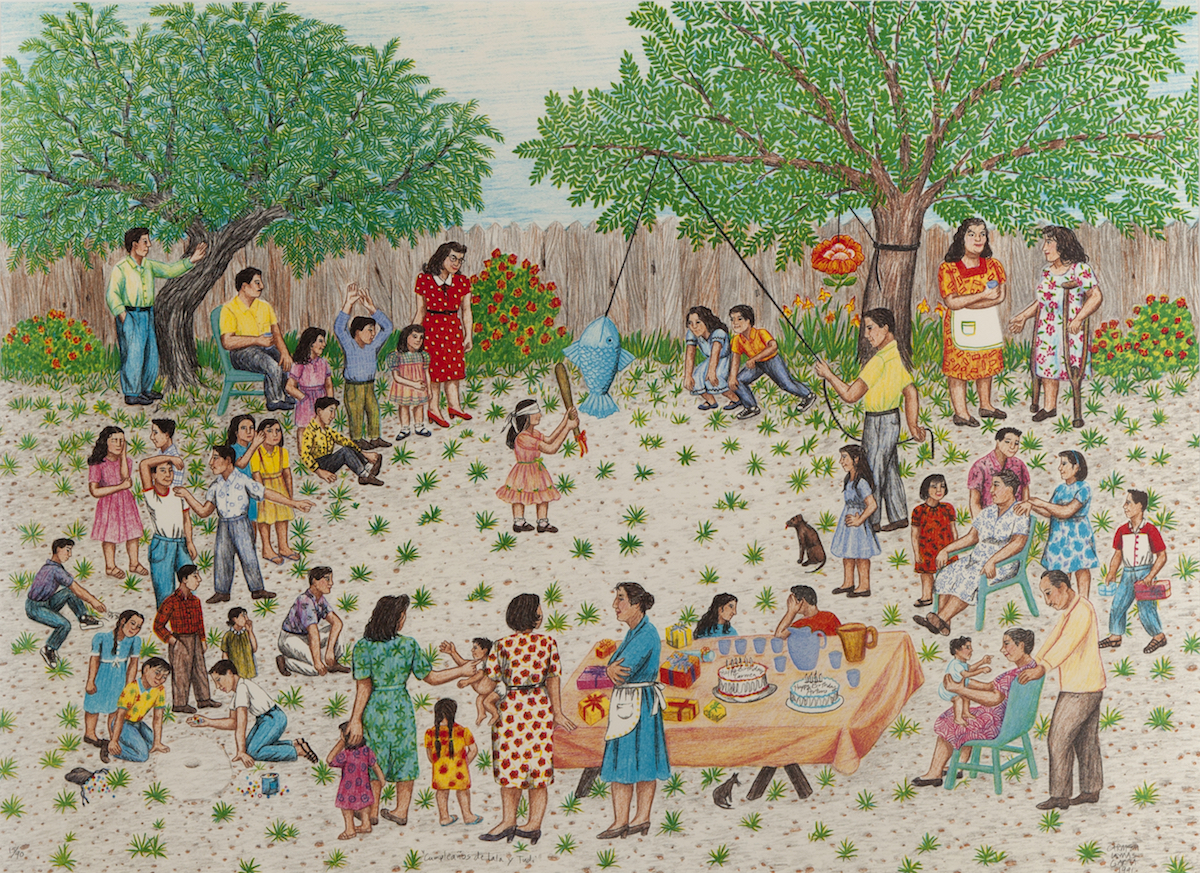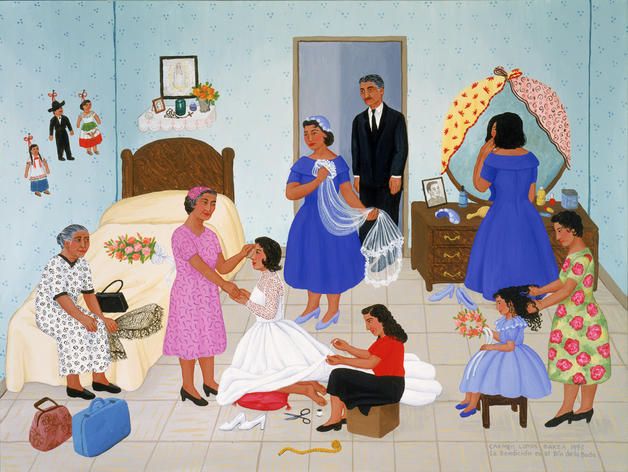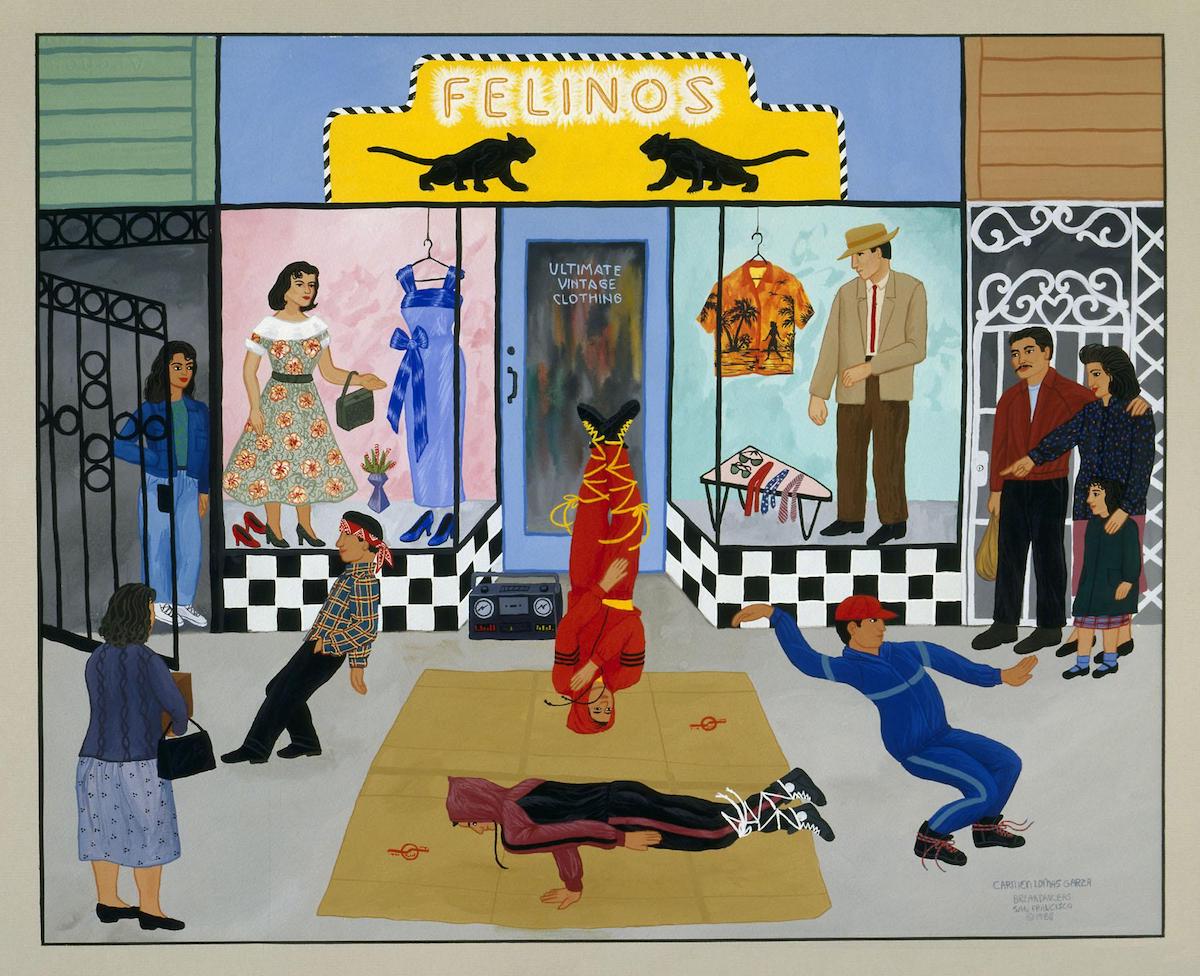I. Traditions and Resistance: Chicanx Heritage in the Bay Area
- Janin Escobedo-Garcia
The San Francisco Bay Area has long been a cultural center for many different racial and ethnic groups, including but not limited to, Mexican and Mexican Americans. The history of Mexican culture varies depending on how Mexican identity is considered. Some may point to their connections to indigenous customs and culture with the mestizo identity, others may point to the arrival of the Spanish military in California and the forced colonization of the San Francisco Bay in 1776. Others still may point to the period between 1821 and 1848 when California was under Mexican governance after the Mexican War of Independence ousted the Spanish. Regardless of the time periods one associates with the arrival or emergence of Mexican culture in the Bay Area, what is undeniable is the existence, resilience, and impact of Mexican culture in the Bay Area.
Two Latinx communities in the Bay Area are the Mission District in San Francisco and the Fruitvale neighborhood in Oakland. While far from being the only predominantly Latinx communities in the area, both of these communities became hubs for community organizing and the arts through the Chicanx movement of the 1960s and 1970s. Those decades were a time of major political, economic, and social upheaval as well as pride for Chicanx people across the Bay Area.
It was during this time period that Carmen Lomas Garza arrived in San Francisco to attend San Francisco State University, and she continues to live and work in the Bay Area. She was born and raised in Texas near the Mexican-United States border. She writes that by the age of thirteen, she had decided to become a visual artist, and that she, “saw the need create images that would elicit recognition and appreciation among Mexican Americans, both adults and children while at the same time serve as a source of education for others not familiar with our culture.”1 These themes of both traditional celebrations and cultural education are found throughout many of her paintings.
Cumpleanos de Lala y Tudi is a narrative painting by Lomas Garza. (Figure 1) The image depicts a typical birthday party in the Mexican tradition. A young girl stands in the center of the composition in the process of hitting a piñata, all around her are family and friends. The title tells us that this is the birthday celebration of two people, Lala and Tudi. None of the family members are named, nor do they stand out in any particular way, with the exception of the girl in the middle of the image. As a result, there is an air of anonymity to the painting. This anonymity transforms this place into a blank canvas for the viewer to interpret and become a part of.
 Figure 1
Figure 1
Lomas Garza transformed a scene and made it relatable to Chicanx viewers. This scene is one where a Chicanx viewer, or someone with similar traditions, could relate immediately to items like the piñata, cake, and bright colors. Familial scenes could also easily be translated to the viewer’s personal life. These familial scenes include aunts, or tias, speaking amongst themselves, cousins, or primos, playing games together, and an uncle, or tio, manipulating the pinata so that others can hit it. Viewers who may not be accustomed to Chicanx or Latinx traditions are also exposed to these traditions. Lomas Garza does this by including English translations in her titles and including traditional American items that overlap with Mexican traditions, like birthday cake.
The image is ambiguous and meant to be translatable to multitudes of people. As a result, the artwork can be translated to any location and any family in the Latinx or Chicanx community. Additionally, the location is not specifically in the San Francisco Bay Area, but this party scene could easily be in Oakland, Hayward, San Francisco, or many other places within the Bay. Additionally, this scene has the potential to be one of Lomas Garza\’s childhood memories from Texas or many other places across the United States.
Another key aspect of this painting is that it is timeless in addition to being geographically ambiguous. While this print is over 25 years old, the scene it depicts could have easily occurred 10 years ago or just last weekend. Many features that would have traditionally dated the scene, such as dress or specific activities, continue to be recognizable to those within the Latinx community. Traditions like the breaking of a pinata have been around for many generations, and will most likely be around for generations to come.
The combination of ambiguity and universality of Lomas Garza’s paintings is also represented in her other artworks. The painting The Blessing on Wedding Day/La Bendicion en el Dia de la Boda is a prime example of this. (Figure 2) In this artwork, a family surrounds a bride in preparation for her wedding day. The people who surround her are depicted in a variety of tasks, including mending the bride’s dress, brushing the flower girl’s hair, and preparing the bride’s veil. At the focal point of the image is the bride with her mother standing over her and giving her a blessing. Nowhere in the image does Lomas Garza name any individual. Clear assumptions can be made based on the dress of the bride and the two identical bridesmaids in royal blue, but everyone else’s role in this scene is debatable. As a person who can relate to this image from personal experience, it is possible to immediately recognize the grandmother sitting on the bed with her dark shawl, that is commonly worn by older women to a Catholic mass, the father of the bride by the door, and of course the mother of the bride giving her blessing. While this scene shows a special occasion, it is also a common event and tradition for Chicanx families across the United States and Mexico. Lomas Garza does not have to name what is happening or who is being depicted, the scene is so ordinary that anyone familiar with wedding traditions knows exactly what is happening. However, just like in the previous image, Lomas Garza provides enough context through the title of the painting for people to understand what is happening in the image.
 Figure 2
Figure 2
Another key painting in conversation with Cumpleanos de Lala y Tudi is Felinos Breakdancers, 1988, also by Lomas Garza. (Figure 3) This is also a narrative image, but it takes on a different subject than the prior ones. Instead of showing scenes of a multigenerational family partaking in a traditional celebration, this scene shows four teenagers in front of a storefront. All of them are breakdancing simultaneously, and a small crowd of onlookers have gathered. The small crowd consists of a young lady by a gate, a middle aged couple with their young daughter on the opposite side of the composition, and an older woman in the foreground. The storefront they are dancing in front of is a vintage clothing store. While it does not appear to be abandoned, no one can be seen entering, exiting, or within the establishment. All four of the teenagers are in the middle of dancing, and everyone around them seems to be enjoying seeing the teenagers dance.
 Figure 3
Figure 3
This scene could have been a common occurrence at the time that Lomas Garza created it. Not only were the 1980’s the height of hip-hop and breakdancing, so was the technology that she painted: the boombox has come to be a symbol of the 1980’s and of hip-hop culture. Instead of depicting the dancers as a nuisance, Lomas Garza shows them in a positive light. She depicts the onlookers enjoying the performance, and by including people of all ages in the small crowd, Lomas Garza shows us that this event was something everyone could enjoy. As in her other works, no geographic location is named, but there is a sense of universality in the piece. This scene could have easily taken place within many different cities across California or the country. However, this painting is unique in that it can be traced to a specific place within the Bay Area. This image is a direct inspiration of a scene Lomas Garza witnessed while stuck in traffic in the Mission District on lower 24th Street.2
While none of these images are representative of a specific place within the Bay Area, they do show the Mexican-American/Chicanx traditions, many of which take place in the region on a daily basis. These paintings not only depict these ordinary events, they also celebrate and revere them. They show that the ordinary is vibrant, beautiful, and worthy of being commemorated. Lomas Garza does not paint scenes of extraordinary wealth or other exceptional subject matter. Instead she paints and reveres the common family and experience.
These paintings of reverence and celebration were painted during a time of turmoil and resistance to the dominant majority’s attempts at assimilation. When Lomas Garza arrived in San Francisco in the summer of 1976, she quickly became involved with the Chicanx art scene and more specifically with the Galeria de La Raza, a local non-profit art gallery and artist coalition of Chicanx and Latinx artists in San Francisco’s Mission District that has been active since 1970.3 They have also been a part of either the creation or preservation of many murals throughout the Mission District. To this day, the Mission District’s artists and their murals are renowned throughout the country as exemplary pieces of Latinx and Chicanx art. Their work, and that of many other artists such as the Mujeres Muralistas, was in conversation with the turmoil and frustrations of the 1970’s and 1980’s. These included wars in Latin America, continued discrimination, and lack of opportunities.4
As of 2019, Lomas Garza’s paintings are between 30 and 20 years old, but they continue their work of celebration and resistance. The Bay Area today faces grand issues of displacement, discrimination, increased costs of living, and the gentrification of traditionally working class or Black and Brown neighborhoods. These images serve the purpose of not only showing celebrations of Chicanx traditions, but also showing the historical vibrancy of the Bay Area. The very continued existence and practice of these traditions within the Bay Area are an act of rebellion against the forceful changes in traditionally Latinx communities. Lomas Garza’s paintings show the hope that Chicanx and Latinx people have had in the Bay Area for generations, and they will continue to live and thrive here for generations to come.
One thing I would like to make clear about Cumpleanos de Lala y Tudi and its role within this exhibit is that the painting is by a self-identified Chicanx artist and that she specifically painted to representations of the Chicanx community. I wish to make this explicit because many times Mexican culture or work is tokenized or presumed to represent the entirety of Latinx cultures and identities. I do not wish to imply that the Chicanx experience or identity is universal to the entirety of the Latinx community. State of Convergence has two artworks by Chicanx artist, and both of them are of Mexican descent. As a result, other communities in the Latinx spectrum are not represented. While themes from Lomas Garza’s work may be identifiable or share connections to multitudes of Latinx communities, it is in no way meant to be a stand in for the hundreds of different Latinx communities that are a part of the Bay Area.
- Carmen Lomas Garza, Artist Statement, 2012.
http://carmenlomasgarza.com/about/artist-statement/. ↩ - Steven A. Nash and Bill Berkson, Facing Eden: 100 Years of Landscape Art in the Bay Area (Berkeley: Univ. of Calif. Press, 1995), 155. ↩
- “Oral History Interview with Carmen Lomas Garza, 1997 April 10-May 27,” Archives of American Art, Smithsonian. https://www.aaa.si.edu/collections/interviews/oral-history-interview-carmen-lomas-garza-13540#transcript. ↩
- Cary Cordova, “Hombres Y Mujeres Muralistas On a Mission: Painting Latino Identities in 1970s San Francisco,” Latino Studies 4, no. 4 (2006): 356–80. https://doi.org/10.1057/palgrave.lst.8600223. ↩